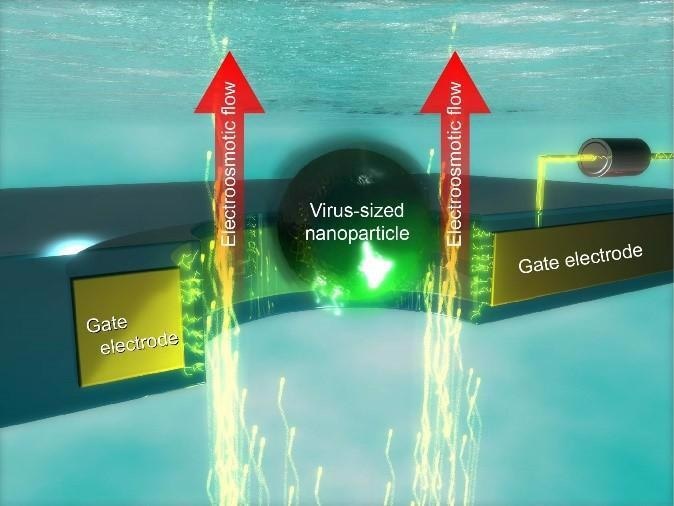Mar 15 2021
At the Institute of Scientific and Industrial Research of Osaka University, researchers have fabricated nanopores in silicon dioxide with a diameter of just 300 nm and encapsulated by electrodes.
 Nanopore electrical tweezer for trapping and manipulating nano-objects in water. Image Credit: Osaka University.
Nanopore electrical tweezer for trapping and manipulating nano-objects in water. Image Credit: Osaka University.
Such nanopores were able to inhibit particles from penetrating when a voltage was applied, which could enable the development of sensors with the ability to detect very little concentrations of target molecules, as well as next-generation DNA sequencing technology.
Nanopores denote very small holes wide enough for the entry of a single particle or molecule. Normally, the movement of nanoparticles via such holes can be detected as an electrical signal, making them a potential platform for innovative single-particle sensors. Until now, it has been very difficult to regulate the motion of the particles.
Researchers at Osaka University made use of the combined nanoelectromechanical systems technology to generate solid-state nanopores, which had a width of just 300 nm, where circular platinum gate electrodes surrounded the openings that can inhibit the entry of nanoparticles. This is achieved by choosing the proper voltage that drags ions in the solution to make a countervailing flow that obstructs the nanoparticle from passing through.
Single-nanoparticle motions could be controlled via the voltage applied to the surrounding gate electrode, when we fine-tuned the electroosmotic flow via the surface electric potential.
Makusu Tsutsui, Study First Author, Osaka University
At the nanopore opening, as soon as the particle is trapped, a slight imbalance in force present between the hydrodynamic drag and electrophoretic attraction can then be developed. At that point, the particles can be gradually dragged, which might enable long polymers, such as DNA, to be threaded through at the proper speed for sequencing.
The present method can not only enable better sensing accuracy of sub-micrometer objects, such as viruses, but also provides a method for protein structural analysis.
Tomoji Kawai, Study Senior Author, Osaka University
Although researchers have already used nanopores to find out the identity of numerous target molecules depending on the current produced, the technology described in this study might enable the testing of a broader range of analytes using this approach. For instance, small molecules, such as proteins and micro-RNA segments that must be pulled in at a highly controlled speed, could also be detected.
Journal Reference:
Tsutsui, M., et al. (2021) Field effect control of translocation dynamics in surround-gate nanopores. Communications Materials. doi.org/10.1038/s43246-021-00132-3.